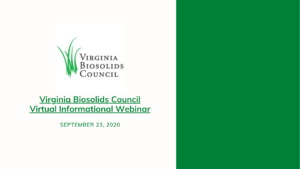 Richmond, VA – The Virginia Biosolids Council hosted a virtual informational session on Wednesday, September 23, featuring national experts who highlighted research on wastewater recovery and biosolids recycling.
Richmond, VA – The Virginia Biosolids Council hosted a virtual informational session on Wednesday, September 23, featuring national experts who highlighted research on wastewater recovery and biosolids recycling.
Dr. Greg Evanylo, a member of the W4170 multistate workgroup, presented the group’s research-based rebuttal to the U.S. EPA’s Office of Inspector General (OIG) report on its biosolids program. He described the process by which members of the W4170 evaluated the risks of more than 360 biosolids-borne constituents which the OIG found wanting in scientific evidence to verify their safety.
Since the release of the OIG report, there have been several scientific rebuttals from various regional and national research communities, as well as the U.S. EPA Office of Water and Office of Enforcement and Compliance Assurance. The W4170 is a United States Department of Agriculture (USDA) Multi-State Research Workgroup, a consortium of research universities, agencies, and experts who have more than 45 years of biosolids research history. Members of this group’s predecessors performed and evaluated much of the research that was used as the basis for the EPA’s biosolids management regulations codified under 40 CFR Part 503.
The analysis of the OIG report by the W4170 included assessing the safety of a variety of organic and inorganic chemicals by comparing their concentrations in biosolids to residential soil screening limits (RSSLs), Part 503 standards, and other environmental and health guidelines. The W4170 response to the OIG report concluded that the pollutants of concern either have low or non-detectable concentrations or have low persistence and are low risk, except for a few that may merit further study. Additional constituents of concern whose occurrence or concentrations in biosolids were deemed to pose low risk were pharmaceuticals & personal care products (PPCPs), hormones & steroids, brominated flame retardants (BFRs), pesticides, dioxin/furans and dioxin-like compounds, a category of “other” organics, certain inorganic elements, and antibiotics and antibiotic bacteria and genes activities.
Dr. Linda Lee with Purdue University then provided a regulatory update on PFAS. Dr. Lee has more than 15 years of experience conducting PFAS research across a range of PFAS subclasses. She has served on multiple national and international advisory groups, addressing water quality issues, fair land-applied biosolid policies, and chemical risk prediction and management.
She highlighted PFAS (Per and Polyfluoroalkyl Substances) characteristics and research at Purdue as well as the growing impact that the increased PFAS-related regulations are having on waste management and the wastewater industry. While PFAS are entering and leaving biosolids as the same or different PFAS, the challenge is preserving the beneficial use of biosolids and protecting water quality by reducing the mobility of PFAS that may be present, using proven methods such as blending and reducing loads in WRRFs.
In addition, Dr. Lee’s research shows that focusing on control sources, optimizing soil amendments, and identifying precursors in biosolids prior to land application will aid in the continued research for sustainable and economical mitigation and treatment options to maximize the value of biosolids and compost and curtail the source of PFAS.
The Virginia Biosolids Council is pleased to provide forums to share the latest research and innovation. The Council remains committed to and supportive of biosolids recycling. Visit the Virginia Biosolids Council website, www.virginiabiosolidscouncil.com to learn more about the ongoing research and science associated with biosolids recycling, or connect with the VBC by sending any questions to info@virginiabiosolids.com.